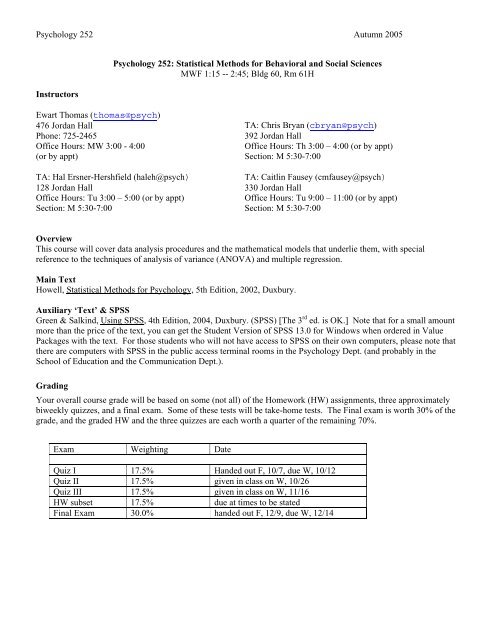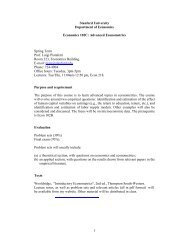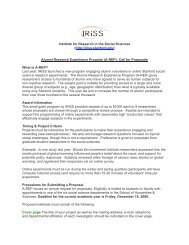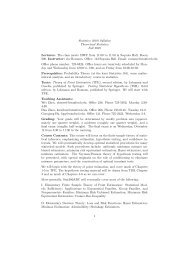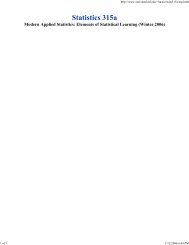Statistical Methods for Behavioral and Social Sciences
Statistical Methods for Behavioral and Social Sciences
Statistical Methods for Behavioral and Social Sciences
You also want an ePaper? Increase the reach of your titles
YUMPU automatically turns print PDFs into web optimized ePapers that Google loves.
Psychology 252 Autumn 2005<br />
Instructors<br />
Psychology 252: <strong>Statistical</strong> <strong>Methods</strong> <strong>for</strong> <strong>Behavioral</strong> <strong>and</strong> <strong>Social</strong> <strong>Sciences</strong><br />
MWF 1:15 -- 2:45; Bldg 60, Rm 61H<br />
Ewart Thomas (thomas@psych)<br />
476 Jordan Hall<br />
Phone: 725-2465<br />
Office Hours: MW 3:00 - 4:00<br />
(or by appt)<br />
TA: Hal Ersner-Hershfield (haleh@psych)<br />
128 Jordan Hall<br />
Office Hours: Tu 3:00 – 5:00 (or by appt)<br />
Section: M 5:30-7:00<br />
TA: Chris Bryan (cbryan@psych)<br />
392 Jordan Hall<br />
Office Hours: Th 3:00 – 4:00 (or by appt)<br />
Section: M 5:30-7:00<br />
TA: Caitlin Fausey (cmfausey@psych)<br />
330 Jordan Hall<br />
Office Hours: Tu 9:00 – 11:00 (or by appt)<br />
Section: M 5:30-7:00<br />
Overview<br />
This course will cover data analysis procedures <strong>and</strong> the mathematical models that underlie them, with special<br />
reference to the techniques of analysis of variance (ANOVA) <strong>and</strong> multiple regression.<br />
Main Text<br />
Howell, <strong>Statistical</strong> <strong>Methods</strong> <strong>for</strong> Psychology, 5th Edition, 2002, Duxbury.<br />
Auxiliary ‘Text’ & SPSS<br />
Green & Salkind, Using SPSS, 4th Edition, 2004, Duxbury. (SPSS) [The 3 rd ed. is OK.] Note that <strong>for</strong> a small amount<br />
more than the price of the text, you can get the Student Version of SPSS 13.0 <strong>for</strong> Windows when ordered in Value<br />
Packages with the text. For those students who will not have access to SPSS on their own computers, please note that<br />
there are computers with SPSS in the public access terminal rooms in the Psychology Dept. (<strong>and</strong> probably in the<br />
School of Education <strong>and</strong> the Communication Dept.).<br />
Grading<br />
Your overall course grade will be based on some (not all) of the Homework (HW) assignments, three approximately<br />
biweekly quizzes, <strong>and</strong> a final exam. Some of these tests will be take-home tests. The Final exam is worth 30% of the<br />
grade, <strong>and</strong> the graded HW <strong>and</strong> the three quizzes are each worth a quarter of the remaining 70%.<br />
Exam Weighting Date<br />
Quiz I 17.5% H<strong>and</strong>ed out F, 10/7, due W, 10/12<br />
Quiz II 17.5% given in class on W, 10/26<br />
Quiz III 17.5% given in class on W, 11/16<br />
HW subset 17.5% due at times to be stated<br />
Final Exam 30.0% h<strong>and</strong>ed out F, 12/9, due W, 12/14
Outline<br />
I. Introduction<br />
(A) A mindset <strong>for</strong> analyzing large data sets (SPSS, Units 1-5; Lessons 38-40. Howell, Ch. 1, 2; 6.3-6.5)<br />
1. Variables in samples & populations; the ‘pam.dat’ data set<br />
2. Indices of location & dispersion <strong>for</strong> qualitative & quantitative variables<br />
3. Chi-square goodness-of-fit & contingency tests; SPSS preliminaries<br />
(B) Probability Theory (Howell, Ch. 5)<br />
1. Probability - unconditional, conditional <strong>and</strong> joint; Bayes’ Theorem<br />
2. Probability distributions of discrete & continuous variables<br />
(C) Sampling distributions <strong>and</strong> hypothesis testing (Howell, Ch. 3 &4)<br />
1. Expected value <strong>and</strong> variance of r<strong>and</strong>om variables; sums of r<strong>and</strong>om variables<br />
2. Binomial <strong>and</strong> Normal distributions; the Central Limit Theorem<br />
3. Null & alternative hypotheses; Type I <strong>and</strong> Type II errors; 1- & 2-tailed tests; effect size<br />
(D) Z- <strong>and</strong> t- <strong>and</strong> Sign-tests (Howell, Ch. 7 & 8)<br />
1. Inference <strong>for</strong> 1 population mean<br />
2. Inference <strong>for</strong> 2 means: Related & Unrelated groups<br />
3. Power<br />
II. Analysis of Variance <strong>and</strong> Experimental Designs (Howell, Ch. 11-13)<br />
(A) Single Factor ANOVA<br />
1. One-way analysis of variance<br />
2. Multiple comparisons in one-factor ANOVA<br />
3. Design issues: determining sample size <strong>and</strong> power<br />
4. Model violations & nonparametric alternatives<br />
(B) Factorial Designs<br />
1. Two-way & three-way fixed effects ANOVA)<br />
2. Fixed, r<strong>and</strong>om, <strong>and</strong> mixed models<br />
3. Multiple comparisons in two-factor ANOVA<br />
4. R<strong>and</strong>omized block design (i.e., 2-way without interaction)<br />
III. Correlation <strong>and</strong> Regression<br />
(A) Correlation <strong>and</strong> simple straight-line regression (Howell, Ch. 5)<br />
1. Formulae <strong>for</strong> covariance, correlation, regression line, s.e. of prediction<br />
2. Assumptions, diagnostics <strong>and</strong> trans<strong>for</strong>mations<br />
(B) Multiple regression & diagnostics (Howell, Ch. 15)<br />
1. Polynomial regression<br />
2. Logistic regression (with a qualitative dependent variable)<br />
(C) Regression Models with Categorical Predictors: GLM (Howell, Ch. 16)<br />
1. Dummy coding <strong>for</strong> (unbalanced) ANOVA designs<br />
2. Analysis of covariance (ANCOVA)<br />
IV. Advanced topics<br />
(A) ANOVA: nested, repeated measures designs<br />
(B) Building Regression Models<br />
1. Variable selection: Best subsets regression<br />
2. Mediational (Path) analysis<br />
Computer<br />
The statistical package SPSS will be used in this course. In addition, there is a class directory in Coursework<br />
2
(https://coursework-e.stan<strong>for</strong>d.edu/coursework/), where you will find homework sets, as well as other miscellaneous<br />
files (e.g. data sets, data analysis examples, etc.). If you do not have a computer account, please see one of the<br />
instructors after class. H<strong>and</strong>outs with some computer tips will be available. Computer issues will also be addressed<br />
by the TAs.<br />
Homework<br />
Problem sets will be h<strong>and</strong>ed out at least once a week. Some will be designated as “HW to be graded” <strong>and</strong> are to be<br />
submitted by the “due date.” Solutions will be provided either in the class directory or by hard copy. The remaining<br />
problem sets, some of them probably longer than necessary to give you a good comm<strong>and</strong> of the subject, are offered as<br />
useful exercises; these do not have to be submitted. You are encouraged to work in groups on all the problem sets.<br />
However, the work you submit <strong>for</strong> grading should be written up independently, even if you worked in a group on it.<br />
Assignments will (often) be posted as files 05h*.ass <strong>and</strong> solutions as 05h*.sol in the class directory.<br />
Honor Code<br />
Each of us should do our utmost to uphold Stan<strong>for</strong>d University’s Honor Code (posted on the Coursework site). You<br />
should not give or receive help from anyone on the quizzes. In the event that something on a quiz is unclear, you are<br />
encouraged to contact one of the instructors about it. As stated in the previous paragraph, you are encouraged to work<br />
in groups on homework assignments; by all means, teach <strong>and</strong> learn from each other! However, the homework<br />
solutions you submit should be written up independently.<br />
Other Comments<br />
1. The TAs will lead a weekly discussion section on Mondays in Rm. 050, Bldg 420 (Psychology).<br />
2. Enrollment in the course is approved <strong>for</strong> six units. Of course, students may enroll <strong>for</strong> 5 units or less.<br />
3


